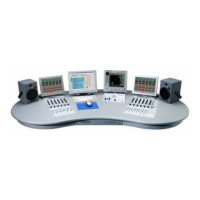OnAir Digital Mixing Consoles
Conguration 6-45
Document generated: 10.10.14
SW V6.0
Force Mode Alink1 Defines the redundancy behaviour of Alink1
Force Mode Alink2 Defines the redundancy behaviour of Alink2
The following settings are possible :
Main only I/O signals on the ‘Redundant’ port are ignored. When the ‘Main’ port loses
a valid A-Link signal, the DSP card will not switch over to the ‘Redundant ‘
port.
Redundant only I/O signals on the ‘Main’ port are ignored. When the ‘Redundant’ port loses
a valid A-Link signal, the DSP card will not switch over to the ‘Main‘ port.
Main Preferred The ‘Main’ port is chosen if both ‘Main’ and ‘Redundant’ port carry a valid
A-Link signal. Complete I/O switch-over to the ‘Redundant’ port when the
valid A-Link signal is lost on the ‘Main’ port.
Redundant Preferred The ‘Redundant’ port is chosen if both ‘Main’ and ‘Redundant’ port carry a
valid A-Link signal. Complete I/O switch-over to the ‘Main’ port when the
valid A-Link signal is lost on the ‘Redundant’ port.
Main Preferred Combining The ‘Main’ port is chosen if both ‘Main’ and ‘Redundant’ port carry a valid
A-Link signal. If one or several I/O signals fail on the ‘Main’ port, it is
checked whether they are still valid on the ‘Redundant’ port. If this is the
case, such signals are then handled through the ‘Redundant’ port. This means
that some of the I/O signals are handled through the ‘Main’ port, and other
signals are handled through the ‘Redundant’ port.
The received signals are then ‘combined’ as if they would be received through
one single port.
This can also be described as : switch-over for single signals instead of switch-
over of the complete port (considering the valid state of every single signal).
Redundant Preferred Combining This mode has the same behaviour as described above, but with the ‘Redun-
dant’ port as a priority.
Note : The combining modes have been implemented for I/O topologies where sev-
eral systems are interconnected through redundant signal paths at the same
time. The combining modes then provide maximal availability of all systems
in case of a failure of a signal path.

